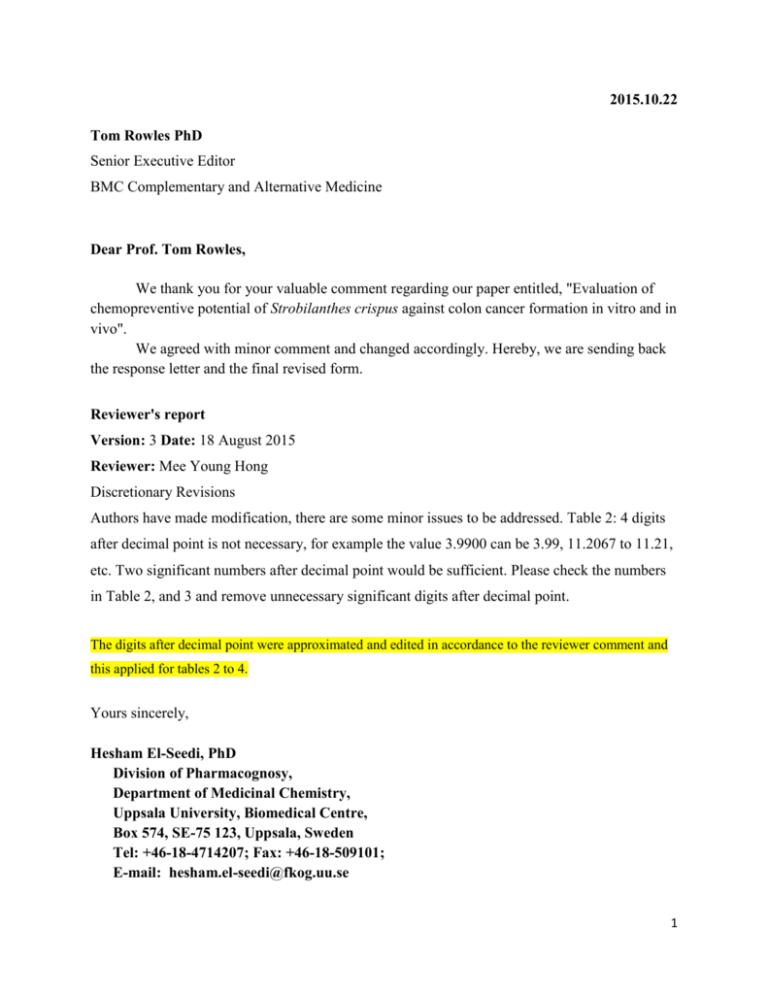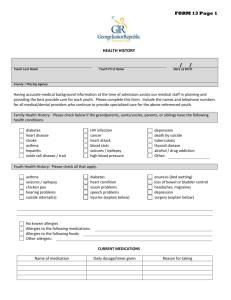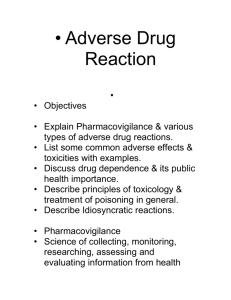2015.10.22 Tom Rowles PhD Senior Executive Editor BMC
advertisement

2015.10.22 Tom Rowles PhD Senior Executive Editor BMC Complementary and Alternative Medicine Dear Prof. Tom Rowles, We thank you for your valuable comment regarding our paper entitled, "Evaluation of chemopreventive potential of Strobilanthes crispus against colon cancer formation in vitro and in vivo". We agreed with minor comment and changed accordingly. Hereby, we are sending back the response letter and the final revised form. Reviewer's report Version: 3 Date: 18 August 2015 Reviewer: Mee Young Hong Discretionary Revisions Authors have made modification, there are some minor issues to be addressed. Table 2: 4 digits after decimal point is not necessary, for example the value 3.9900 can be 3.99, 11.2067 to 11.21, etc. Two significant numbers after decimal point would be sufficient. Please check the numbers in Table 2, and 3 and remove unnecessary significant digits after decimal point. The digits after decimal point were approximated and edited in accordance to the reviewer comment and this applied for tables 2 to 4. Yours sincerely, Hesham El-Seedi, PhD Division of Pharmacognosy, Department of Medicinal Chemistry, Uppsala University, Biomedical Centre, Box 574, SE-75 123, Uppsala, Sweden Tel: +46-18-4714207; Fax: +46-18-509101; E-mail: hesham.el-seedi@fkog.uu.se 1 2015.06.28 Tom Rowles PhD Senior Executive Editor BMC Complementary and Alternative Medicine Dear Prof. Tom Rowles, We thank you for your valuable comments regarding our paper entitled, "Evaluation of chemopreventive potential of Strobilanthes crispus against colon cancer formation in vitro and in vivo". We agreed with most of the reviewer comments and found them very interesting to discuss. Thus, we want to extend our appreciation for taking the time and effort necessary to provide such insightful guidance. Hereby, we are sending back the response letter considering every single comment as stated below. We are submitting our manuscript on the referred link twice; one is in the final form and one as revised manuscript with labelled changes. Yours sincerely, Hesham El-Seedi, PhD, Professor Division of Pharmacognosy, Department of Medicinal Chemistry, Uppsala University, Biomedical Centre, Box 574, SE-75 123, Uppsala, Sweden Tel: +46-18-4714207; Fax: +46-18-509101; E-mail: hesham.el-seedi@fkog.uu.se Reviewer's report: Authors have made substantial modification. The manuscript is now much more strengthened by the modification. However, the following issues still need to be addressed. Authors should have pointed out where the changes were made using line number or highlighted the changes. It took me a really long time to review the revision. 1. In the revised background of the abstract, the aim of the study was removed. 2 The objective of the study is still not clear in the introduction. Please clearly state the objective of the study in the abstract and introduction. We have revised and amended the section 2. Has the justification of the dosage which authors responded to the reviewer’s comment been addressed in the manuscript? The Acute study was conducted according to the OECD guidelines for chemicals using a fixeddose procedure. The protocol of the guidelines is based on dosing a group of animals, primarily rats and normally females with fixed doses of 5, 50, 300 and 2000 mg/kg. The chosen dose should not be lethal but to induce sub-acute or acute toxicity signs. The single dose was administrated as a gavage by stomach tube into the fasting animal and the observations are reported on daily bases and the animals are weighted weekly OECD: Acute oral toxicity, guideline 407, the OECD guideline for testing of chemical. 2006 http://dx.doi.org/10.1787/9789264070684-en. A principle of the method is that in the main study only moderately toxic doses are used, and the administration of doses that are expected to be lethal should be avoided. This Guideline is intended primarily for use with rat. Groups of animals of a single sex (normally females) are dosed in a stepwise procedure using the fixed doses of 5, 50, 300 and 2000 mg/kg (exceptionally 5000 mg/kg). The initial dose level is selected on the basis of a sighting study as the dose expected to produce some signs of toxicity without causing severe toxic effects or mortality. Further groups of animals may be dosed at higher or lower fixed doses, depending on the presence or absence of signs of toxicity or mortality. This procedure continues until the dose causing evident toxicity or death is identified, or when no effects are seen at the highest dose or when deaths occur at the lowest dose. The test substance is administered in a single dose by gavage using a stomach tube or a suitable intubation cannula. Animals should be fasted prior to dosing. A total of five animals of one sex will normally be used for each dose level investigated. The results of this study include: measurements (weighing at least weekly) and daily detailed observations, as well as gross necropsy. The method provides information on the hazardous properties and allows the substance to be classified for acute toxicity according to the Globally Harmonised System of classification and labelling of chemicals. 3. Be consistent on the significant numbers after decimal point in the tables. They were all checked. 3 4. Previous review asked to include specific p-values in the statement but it was not made. Please include specific p-values if results are statistically significant It was added. 5. Table 2: It is not clear the p-values are compared to normal or AOM group. It was clarified. 6. Table 3: What are the ‘*’, ‘**’ and ‘***” symbols for? To distinguish the significant between the different treatments. The numbers of the stars are reflecting the proportion as from high to average. 7. Table 4: Foot note should be rearranged. It was rearranged. 8. Figures 2 and 3 do not add information to Table 3 and can be removed. The two figures 2 and 3 were merged in one figure to show the table data in a clear view. 9. Figure 4. There are no statistical marks. It was added and its number was changed to figure 3 10. Figure 5. It is confusing whether the data are inhibition % or viability %. What was the N each experiment? Please include SE bars to see the variability of the data. It was justified and the figure number changed to figure 4. 11. Method section is very lengthy and should be succinct. The method section has been shortened to comply with the reviewer´s suggestion. 12. Clinical human application regarding the doses should be discussed. Clearly, the relevant dosage to human studies was not stated, therefore we have to refer to another study to clarify this point: In previous study by Fujita and Yamagami 2008, the dosage of the Chinese’s black tea under investigation was controlled and tested in animal models (however mice) relative to humans. Animals received 2,000 mg/kg whereas humans were given 0.75 or 1 g/day. The safety study showed no changes in hematological or relevant biochemical parameters in both mice and humans in the toxicity tests. 4 In our study, this particular dose was chosen based on IC50 values obtained from MTT tests. We used this concentration in the biological assays as it is in correspondence to the IC50 value for 48 hours of treatment as previously described. Fujita H, Yamagami T. Efficacy and safety of Chinese black tea extract in healthy and hypercholesterolemic subjects. Ann Nutr Metab. 2008; 53(1):33-42. 5







